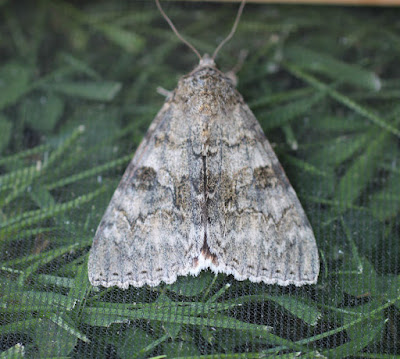 |
| Leopard Moth (Zeuzera pyrina) |
Such a striking moth is the Leopard (Zeuzara pyrina). This is only the second time that this species has been seen in the garden. As the pupa overwinters, sometimes for two or three years, it is possible that the eggs laid by the previous Leopard (in 2012) have hatched, pupated and transformed into the flying adult that came to the trap last night. The moth was found outside the trap on the white sheet where you would think it would be easy prey for predators. As the only previous record was found in similar circumstances perhaps the distinctive colouring acts as a warning and it doesn't need to hide.
The moth's legs terminate in very 'sticky' feet and when disturbed it curls up, slumps and appears to be dead. It took some time before it could be persuaded to cling onto a leaf and then be carried to an apple branch and photographed. An apple or pear tree is the home of the caterpillar for the majority of its life. The adult does not feed.
The scientific name is a typographical error. The binomial should have begun with 'zenzura', the Italian name for a gnat, from zenzero (ginger) referring to the sharpness of the gnat's bite and the pupa's jaws - this caterpillar tunnels through branches. P. A. Latreille, a distinguished French entomologist, gave the species the name but either the printer or the expert himself failed to spot the typo. My bet is on the printer.
The moth's legs terminate in very 'sticky' feet and when disturbed it curls up, slumps and appears to be dead. It took some time before it could be persuaded to cling onto a leaf and then be carried to an apple branch and photographed. An apple or pear tree is the home of the caterpillar for the majority of its life. The adult does not feed.
The scientific name is a typographical error. The binomial should have begun with 'zenzura', the Italian name for a gnat, from zenzero (ginger) referring to the sharpness of the gnat's bite and the pupa's jaws - this caterpillar tunnels through branches. P. A. Latreille, a distinguished French entomologist, gave the species the name but either the printer or the expert himself failed to spot the typo. My bet is on the printer.
 |
| Leopard Moth (illustration) |
Wonder of wonders a Red Underwing was also in the trap. A fine, recently hatched creature that was as impatient and edgy as every other one I have ever seen. Getting a decent image of its glorious red hindwings might have lead to its escape and I was concerned that it would just get snapped up by one of the numerous birds that gather around the trap. The flycatchers seem to have disappeared but there are plenty of other species happy to get breakfast on a plate.
The Red Underwing (Catolcala nupta) 'the bride with beauty beneath' refers to the brightly coloured petticoats (hindwings) that Linnaeus seems to be describing. The photograph doesn't give a clear enough impression as to how big this moth is, but if you see one (and this is only the third I have seen in North Yorkshire in six years), you will be surprised.
The hand-coloured image does the moth justice. The depth of colour is accurate.
 |
| Red Underwing (illustration) |
 |
| Iron Prominent (Notodonta dromedarius) |

